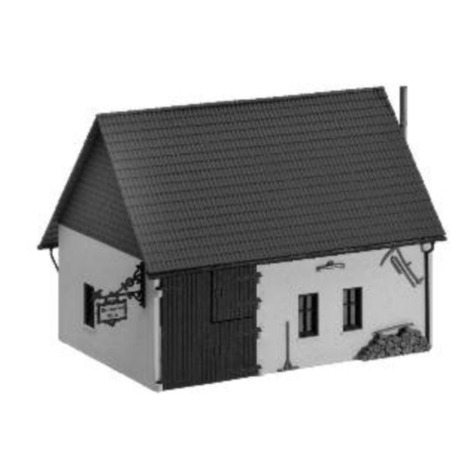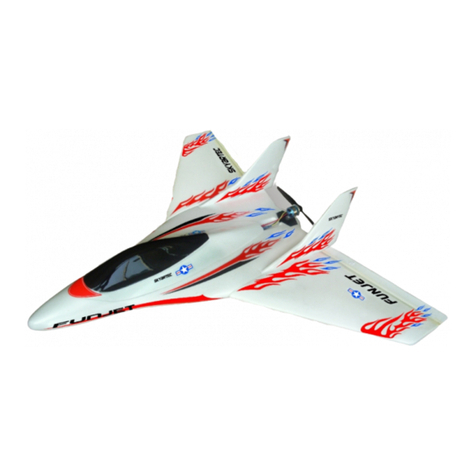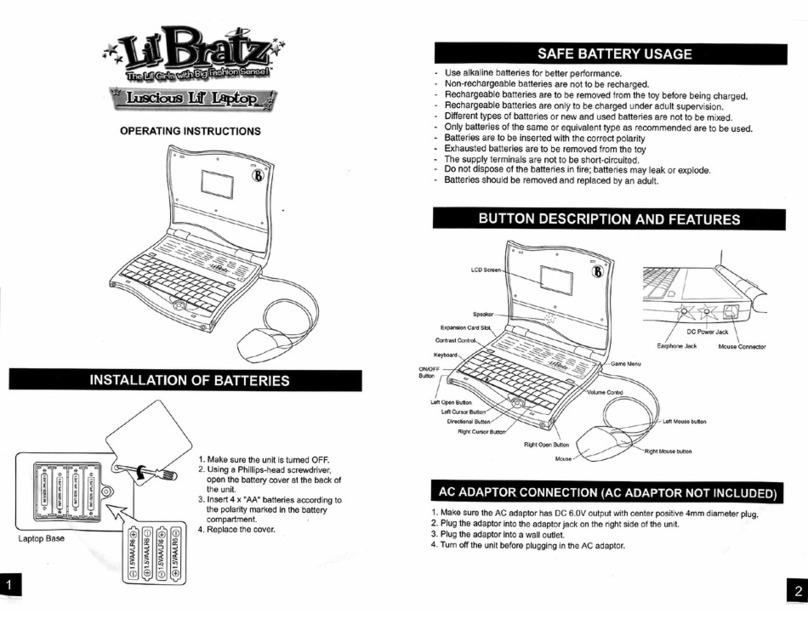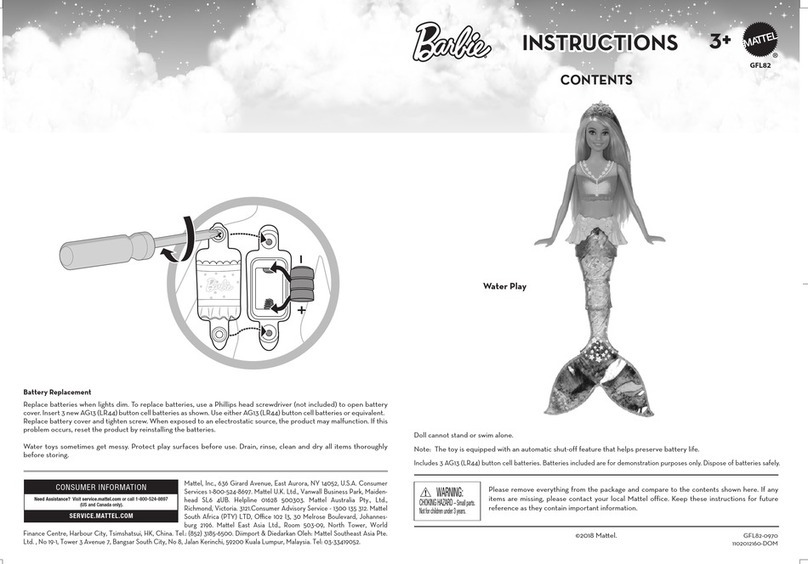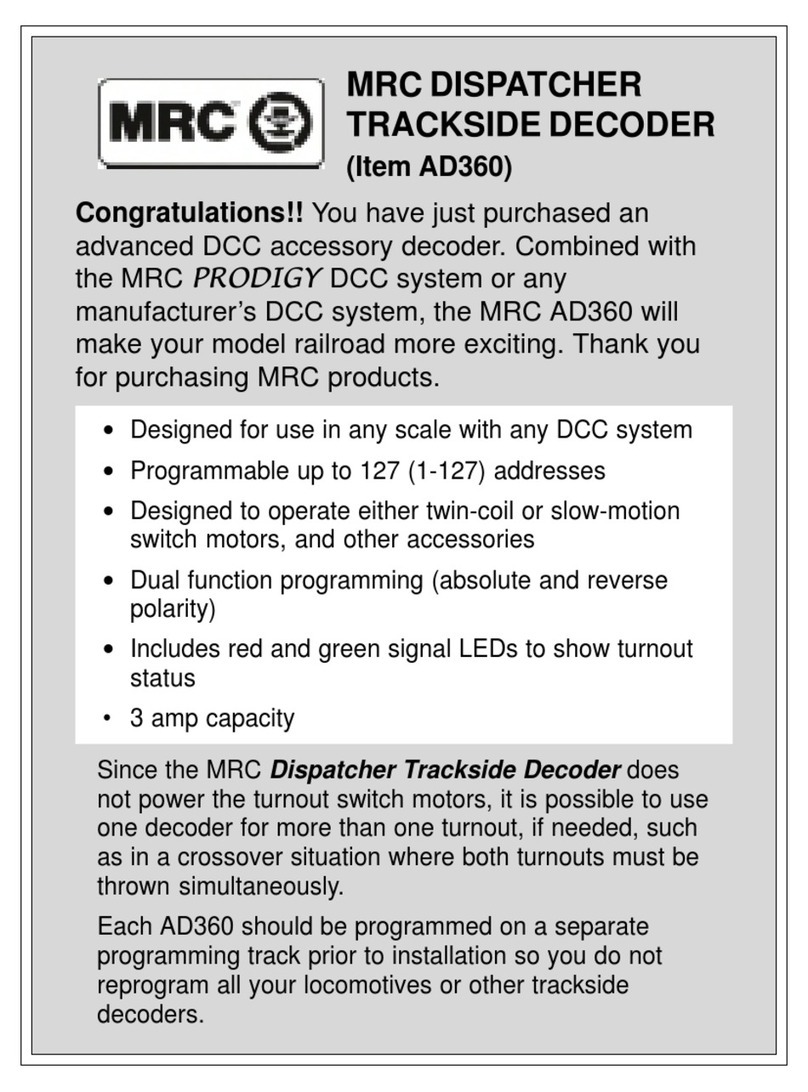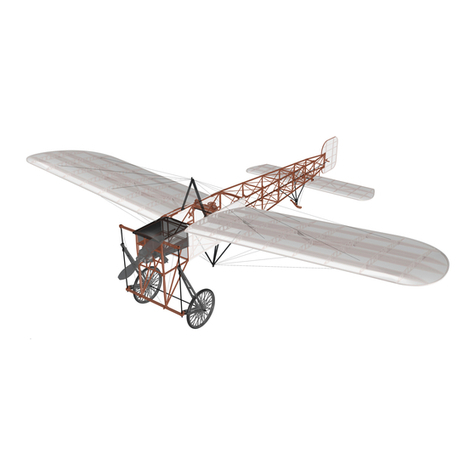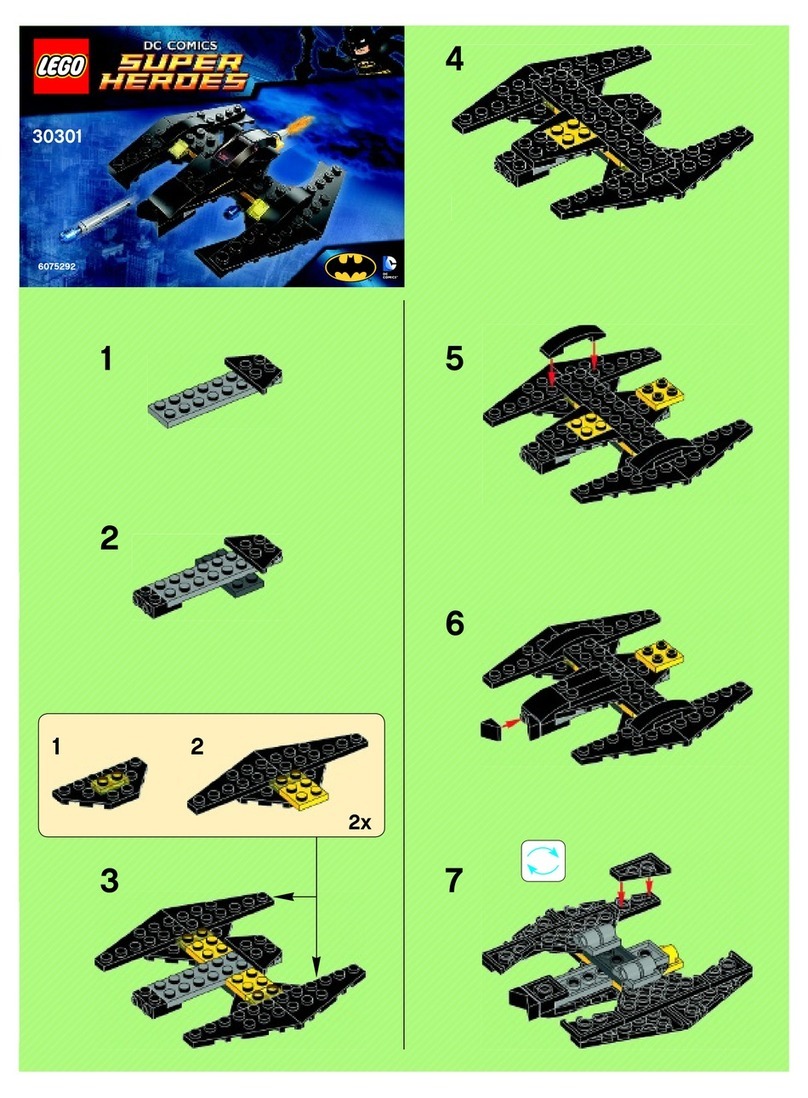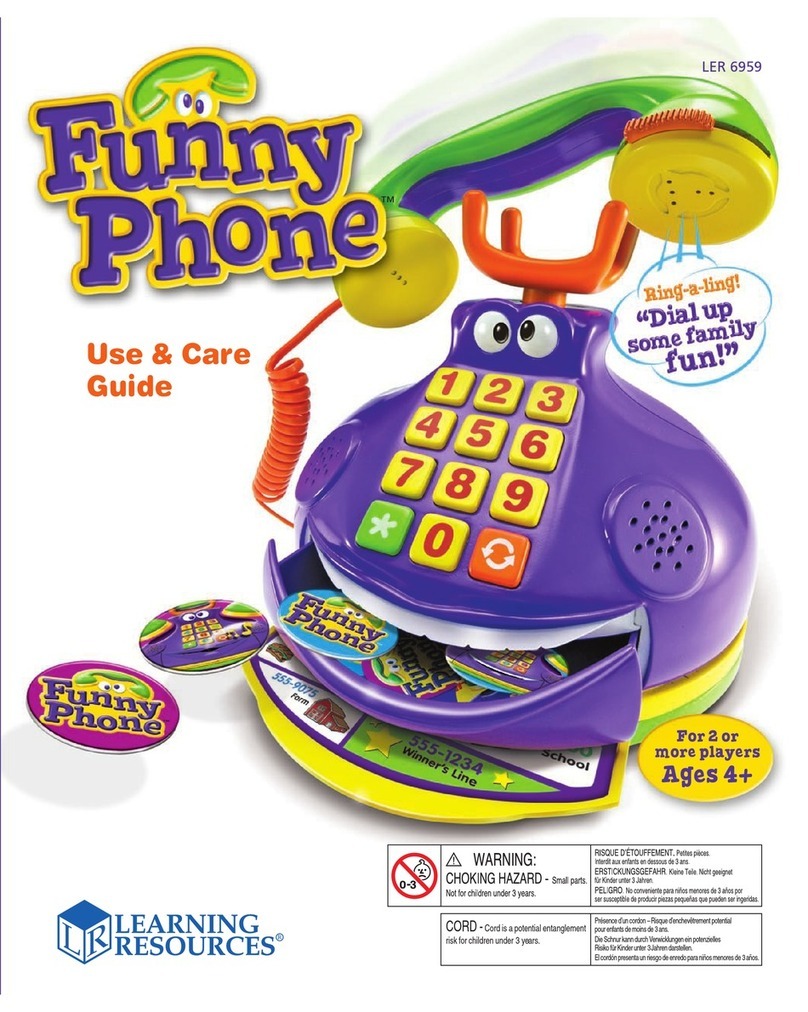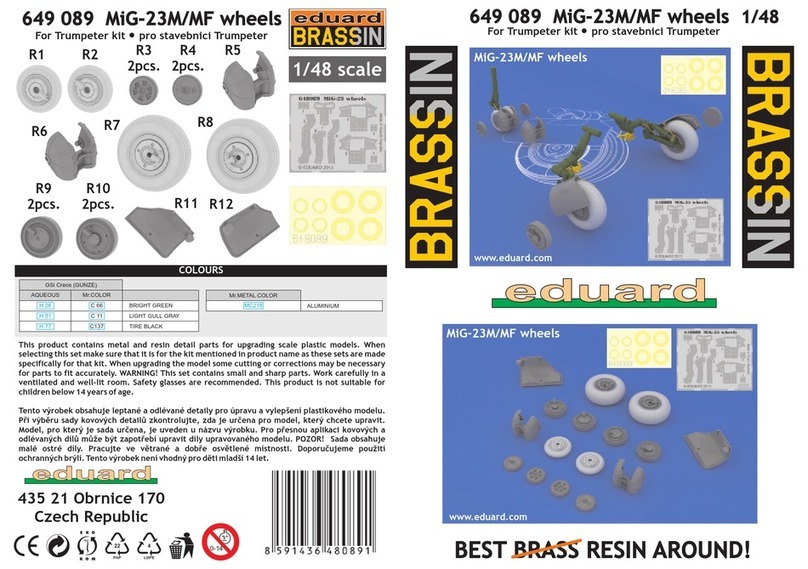PREMIER AIRCRAFT QQ EXTRA 300G2 User manual

Day & Night Versions
Day & Night Versions
G2G2


1
BEFORE CONTINUING WITH THIS INSTRUCTION MANUAL OR ASSEMBLY
OF YOUR AIRCRAFT, PLEASE VISIT OUR WIKI SUPPORT SITE FOR THE
LATEST PRODUCT UPDATES, FEATURE CHANGES, MANUAL ADDENDUMS
AND FIRMWARE CHANGES FOR BOTH YOUR AIRCRAFT AND THE
INSTALLED ELECTRONICS.
wiki.flexinnovations.com/wiki/QQExtra300G2
wiki.flexinnovations.com/wiki/Aura

TABLE OF CONTENTS
INTRODUCTION
The perfect first 3D aerobat!
The QQ Extra 300G2 is the evolution and accumulation of many years
of design experience. A perfectly balanced airframe design combined
with today’s most advanced control system gives an unmatched flying
experience. Pilots will feel smooth, precise aircraft control without any
interference to pilot inputs. The aircraft will y as if it were much larger,
turbulent air will be less noticeable, rotations will stop more precisely
and landing will be easier to execute.
The Generation 2 (G2) QQ Extra 300 takes the original experience to
the next level, by including a more powerful power system, new
servos, new Aura 8 Firmware with bounceback control and much
more!
For the latest updates, features, addendums and more, before
assembly, please visit:
wiki.flexinnovations.com/wiki/QQExtra300G2
wiki.flexinnovations.com/wiki/Aura
Pre-installed and custom-tuned Aura 8 Advanced
Flight Control System with bounceback control
Updated 1400kv motor and 50A ESC for more power
(4) High-Precision Potenza DS-15 servos
Light wing loading for easy handling
3-6 minute flight times depending on battery choice
and throttle management
Designed around the popular 3S 2200mAh battery
Light Weight EPO foam that is durable and easy to
repair
Night version now includes LEDs in the fuselage
Introduction
Box Contents
Specifications
Replacement Parts
Optional Accessories
Completion Items
Battery Charging Guidelines
Special Language Definitions
Important Information Regarding Warranty
Safety Warnings and Precautions
Low Voltage Cutoff
Main Landing Gear Installation
Optional Wheel Pant Removal
Tailwheel Installation
Aura 8 AFCS
Transmitter Setup
Connecting a Battery/Arming the ESC
Receiver Installation/Servo Connections
Horizontal Stabilizer Installation
Main Wing Installation
SFG Installation
Battery Installation
Transmitter Control Direction Test
Aura 8 Sensor Direction Test
Propeller and Spinner Installation
Center of Gravity
Pre-Flight Checks
Flying your QQ Extra 300G2
Airframe Repairs
Replacing Servos
Servicing the Power System
Aircraft Troubleshooting Guide
Limited Warranty
AMA Safety Code
2
2
3
3
3
3
3
4
4
4
4
5
6
6
7
8
9
..........................................................................
.......................................................................
......................................................................
..............................................................
...........................................................
................................................................
...............................................
..............................................
.........................
.......................................
..............................................................
............................................
............................................
...........................................................
........................................................................
................................................................
................................
....................................
..................................................
.................................................................
...........................................................................
.......................................................................
...............................................
.......................................................
................................................
..........................................................................
........................................................................
.......................................................
..........................................................................
........................................................................
........................................................
....................................................
..........................................................................
........................................................................
10-12
13
14
15
16
17
18
19
20
20
21
22
22
23
24
25
26
BOX CONTENTS
2

COMPLETION ITEMS
Potenza 10 1400 Kv Brushless
Outrunner Motor (FPZM1010C)
ZTW 50A ESC with 5V/8A BEC
(ZTW50ABEC)
Potenza DS15 Digital Servos
(FPZDS15)
Aura 8 Advanced Flight Control
System (FPZAURA08ZZE300G2)
11.5 x 4.5 Electric SR Propeller
(FPMP1145E)
2100-3300mAh 3S 11.1V 35C+ Li-Po
(FPZB22003S45)
6+ Channel Computer Transmitter
NEEDED TO
COMPLETE
INSTALLED!
INSTALLED!
SPECIFICATIONS
47.8 in. (1215mm)
47.8 in. (1215mm)
Standard: 3lb 1oz. (1390g)
RTF with 3S 2200mAh ba�ery installed
572.5 sq. in.
(40 sq. dm.)
BATTERY CHARGING GUIDELINES
The assembly of the QQ Extra 300G2 can be accomplished in
less than one hour. Prior to assembling the airplane, it is
advisable to charge your battery so that you are ready to begin
setup upon completion of the assembly of your model.
We recommend the use of an advanced Li-Po balancing
charger for your batteries to get the maximum performance
and lifespan.
Our airplanes are designed around our Potenza Li-Po
batteries, and we recommend the Potenza 3S 2200mAh 45C
Li-Po based on our extensive testing and development. These
batteries feature an EC3 connector, so no soldering is required
for use in your QQ Extra 300G2.
All are available at www.flexinnovations.com
WARNING
FOLLOW ALL INSTRUCTIONS PROVIDED BY YOUR
BATTERY AND CHARGER MANUFACTURER.
FAILURE TO COMPLY CAN RESULT IN FIRE.
OPTIONAL ACCESSORIES
Receiver
INSTALLED!
INSTALLED!
INCLUDED!
NEEDED TO
COMPLETE
NEEDED TO
COMPLETE
Spektrum DSMX Remote Receiver(s)
Spektrum SRXL
Futaba S.Bus
Hitec S.Bus
Graupner SumD,
JR XBus Mode B
Jeti UDI 12
6+ Channel Receiver (any brand)
REPLACEMENT PARTS
3
FPM307001
FPM378001
FPM307002
FPM378002
FPM307003
FPM307004
FPM307005
FPM307006
FPM307007
FPM37708
FPM37709
FPM307010
FPMA0003
FPMP11545E
FPZM1010C
FPZM1010A1
FPZM1010A2
FPZM1010A3
FPZA1016
ZTW50ABEC
FPZAURA08ZZE300G2
FPZAU02
Fuselage (Day)
Fuselage (Night)
Wing Set (Day) with SFGs
Wing Set (Night) with SFGs
Tail Set with Rudder
Cowling and Hatch Set
Landing Gear with Wheels & Wheel Pants
Wing and Stab Tube Joiner Set
Pushrod Set
Red/Black Decal Set
Green/Black Decal Set
Spinner
Plastic Clevis Set (10)
SR 11.5 x 4.5E Propeller
Potenza 10 1400kv Motor (3S)
5mm Collet Prop Adapter
Potenza 10 Aluminum X-Mount with Screws
Potenza 10 5mm Motor Shaft with Collar
Potenza Advanced LED Controller
ZTW 50A ESC 3S/6S with 8A BEC
Potenza Aura 8 AFCS for QQ 300G2
Aura Micro-USB to USB Cable
FPZAU01
FPZB22003S45
FPZB26003S45
FPZM1010D
FPMPAPC1245MR
FPZB22004S40
FPZB26004S45
FPZA1010
ZTWCARD
SPMAR8010T
SPM9745
FUTR2001SB
FUTR7003SB
FUTT6K
Potenza 3pc. Male-Male Servo Connectors
Potenza 3S 2200mAh 45C Li-Po
Potenza 3S 2600mAh 45C Li-Po
Potenza 10 1070kv Motor (for 4S batteries)
APC 12x4.5 MR Propeller (for 4S)
Potenza 4S 2200mAh 40C Li-Po
Potenza 4S 2600mAh 45C Li-Po
Potenza Digital Battery Analyzer
ZTW ESC Programming Card
Spektrum AR8010T DSMX Receiver
Spektrum DSMX Remote Receiver
R2001SB S.BUS S-FHSS Receiver
R7003SB S.BUS FASSTest Receiver
Futaba T6K Transmitter w/R3006SB Reeiver
(Recomended
SPM Receiver)
(Recomended
FUT Receiver)

The following terms are used throughout the product literature to indicate various levels of potential harm when operating this product:
SPECIAL LANGUAGE DEFINITIONS
ATTENTION
WARNING
AGES 14+
NOTICE:
CAUTION:
WARNING:
Procedures, which if not properly followed, create a possibility of physical
property damage AND a little or no possibility of injury.
Procedures, which if not properly followed, create the probability of physical
property damage AND a possibility of serious injury.
Procedures, which if not properly followed, create the probability of property
damage, collateral damage, and serious injury OR create a high probability of
serious injury.
Read the ENTIRE instruction manual to become familiar with the features of the
product before operating. Failure to assemble or operate the product correctly can
result in damage to the product, personal property, and cause serious or fatal injury.
All instructions, warranties and other collateral documents are subject to change at
the sole discretion of Flex Innovations, Inc. For up-to-date product literature, please
visit our website at www.flexinnovations.com and click on the appropriate product
pages.
This product is not intended for
use by children under 14 years
without direct adult supervision.
IMPORTANT INFORMATION REGARDING WARRANTY
SAFETY WARNINGS AND PRECAUTIONS
Please read our Warranty and Liability Limitations section before building this product. If you as the Purchaser or user are not
prepared to accept the liability associated with the use of this Product, you are advised to return this product immediately in
new and unused condition to the place of purchase.
LOW VOLTAGE CUTOFF
Protect yourself and others by following these basic safety guidelines.
1. This manual contains instructions for safety, operation and maintenance. It is essential to read and follow all the
instructions and warnings in the manual, prior to assembly, setup or use, in order to operate correctly and avoid damage or
serious injury.
2. This model is not a toy, rather it is a sophisticated hobby product and must be operated with caution and common sense.
This product requires some basic mechanical ability. Failure to operate this product in a safe and responsible manner could
result in injury or damage to the product or other property.
3. This model must be assembled according to these instructions. Do not alter or modify the model outside of these
instructions provided by Flex Innovations, Inc. as doing so may render it unsafe and/or unflyable. It is your responsibility to
ensure the airworthiness of the model.
4. Inspect and check operation of the model and all its components before every flight.
5. If you are not an experienced pilot or have not flown a high-performance model before, it is recommended that you seek
assistance from an experienced pilot in your R/C club for your first flights. If you're not a member of a club, the Academy of
Model Aeronautics (AMA) has information about clubs in your area whose membership includes experienced pilots.
6. Keep the propeller area clear from such items as loose clothing, jewelry, long hair, or tools as they can become entangled.
Keep your hands and body parts away from the propeller as injury can occur.
7. Never fly in visible moisture, or submerge the airplane or any of its electronic components in water. Permanent damage to
electronic components may occur, or corrosion of components may lead to intermittent failures.
Li-Po batteries have a nominal (rated) voltage of 3.7V per cell, and fully charged, reach 4.2V per cell. Batteries are designed
to be discharged below the nominal voltage, however, if they are discharged below 3.0V per cell, damage will occur and the
pack will lose capacity. For best long term battery life, set a timer and land after a time that leaves approximately 15% of the
battery's capacity remaining.
Low voltage cutoff is a feature that is built into the ZTW 50A ESC that is designed to protect the connected battery from being
discharged too far and causing permanent damage to the cells. Circuitry within the ESC will automatically detect when the
input voltage from the battery pack reaches below 3.15V per cell (average) and will remove power to the motor, but still
deliver power to the servos so that a safe landing may be made. If the motor begins to lose power rapidly during flight, the
LVC has sensed that the total voltage of the pack has dropped below 3.15V per cell average, and the airplane should be
landed immediately. 4

MAIN LANDING GEAR INSTALLATION
Required Tools and Fasteners: #1 Phillips Screwdriver
(4) M3x10 Phillips Head Self-Tapping Screw
1.
2.
.
Insert the landing gear assembly into the slot in the bottom of the fuselage. The landing gear will sweep forward as it moves away
from the fuselage.
Insert the landing gear retaining plate over the landing gear and into the slot in the fuselage, and secure it with the (4) M3x10
Phillips Head self-tapping screws.
5
TECH TIP: For added support and longevity in the event of hard landings, you can apply some clear silicone into the
landing gear slot prior to inserting the landing gear into the fuselage. Once the landing gear has been inserted
into the fuselage, apply more silicone before securing the retaining plate to the fuselage. The landing gear can
still be removed easily for repair or replacement.

TAIL WHEEL INSTALLATION
Required Tools and Fasteners: #1 Phillips Screwdriver
(3) M3x10 Phillips Head Self-Tapping Screw
1.
2.
.
Insert the tailwheel assembly into the slot in the bottom of the rudder.
Install the tailwheel retaining plate over the tailwheel wire, and secure it in place with the (3) M3x10 Phillips head self-tapping
screws.
6
OPTIONAL WHEEL PANT REMOVAL
Required Tools and Fasteners: #1 Phillips Screwdriver
1.5mm Hex Driver
(2) Wheel Collars
1.
2.
3.
.
Invert the airplane and locate the two wheel pant retaining screws and remove them. Slide the wheel pant and wheel off the axle.
Remove the wheel from the wheel pant and reinstall on the axle.
Slide the wheel collar onto the axle with the shoulder (offset) towards the wheel. Apply blue thread lock on the setscrew and
tighten.
For pilots that want the lightest possible setup, or for those that fly off of unimproved fields, the wheelpants on the QQ Extra 300G2
are removable. Two wheel collars have been provided in the hardware bag to retain the wheels after the wheelpants are removed.

7
Description of Pre-Loaded Aura Flight Modes (FM)
Each of the modes has been tuned by our team to offer a solid
start. Because tastes in control feel are unique, if changes in
rates and expo are needed, adjustments should be made
through the Aura.
Changes in gain value can only be made through the Aura.
REFERENCE ONLY: Aura Settings
Aura 8
Rate Setup
Aileron
Elevator
Rudder
Mode 1 Mode 2 Mode 3
REFERENCE ONLY
Aileron
Elevator
Rudder
Aura 8
Expo Setup
AURA 8 AFCS
Works conveniently with all major radio systems
Accepts signals from DSM Remote Receiver(s), Spektrum
SRXL, Futaba S.Bus, Graupner Hott (Sum D of 8), JR
XBus (Mode B), Jeti UDI12 (standard), Hitec S.Bus, PPM
Stream, or any brand of receiver via male to male servo
connectors
Expertly tuned and ready to use
USB port allows loading model configurations, user
programming, and firmware updates (cable included)
Flexible and extensive programming through Windows-
based PC or tablet
3+ flight modes allow precise or aggressive settings to be
selected in flight
3-axis gyro utilized in QQ Extra 300G2 programming
The Aura 8 Advanced Flight Control System (AFCS) installed in
your QQ Extra 300G2 is a giant leap forward in aircraft flight control
system technology. Compatible with virtually every receiver on the
market today, the Aura features special configuration for DSM
systems via remote receiver connection(s), and serial data
connection for Futaba or Hitec S.Bus, Spektrum SRXL, Graupner
HOTT (Sum D of 8), JR XBus (Mode B), and Jeti UDI12 (standard)
systems, as well as being compatible with traditional receivers via
PWM servo connections.
The Aura 8 advanced flight control system in your QQ Extra 300G2
has been pre-tuned for ease of use, eliminating many hours of
tedious setup. For the latest Aura features, programs, transmitter
downloads, and instructions, please visit wiki.flexinnovations.com/
wiki/Aura
The Aura is programmable through any Windows based PC or
tablet. All dual rate, expo, travel, and assignable mode programs
are adjusted inside the Aura through the PC application. An
assignable master gain that is OFF by default can be enabled by
the Aura application. If desired, assign CH 8/AUX 3 on a
proportional dial or slider.
By default, CH5/Gear is used to select the 3 flight modes by 3
position transmitter switch. CH6/Aux 1 is used to select the on/
off position of the LED controller by 2 position transmitter switch
(night version only).
Visit wiki.flexinnovations.com/wiki/Aura for the
latest Aura-related product information and
tips for your particular radio brand.
Mode 1 (Gyro Off): Rates are set for general flight (same as
Sport Mode). Exponential is tuned for comfortable flight.
Mode 2 (Sport Mode): Gains are moderate and tuned for
comfortable feel/best performance for precision aerobatics.
Aileron and elevator rates are low and expo is tuned for
comfortable flight.
Mode 3 (3D Mode): Gains are highest and tuned for 3D
aerobatics. Rates are set to highest. Exponential is tuned for
comfortable flight.
100%
100%
95%
Mode 1 Mode 2 Mode 3
30%
25%
30%
15%
10%
25%
30%
25%
25%
DO NOT PROGRAM THESE VALUES INTO
YOUR TRANSMITTER!
NOTICE
The shown Aura 8 settings are pre-configued and the unit is ready
to use. The chart shown is for informational purposes only. No
additional action is required to fly the airplane.
REFERENCE ONLY: Aura Settings
40%
23%
95%
40%
23%
95%

TRANSMITTER SETUP
WARNING
The Aura 8 AFCS is designed to work seamlessly with all major transmitter and receiver brands. When programming your transmitter, start
with a freshly reset new model memory in your transmitter. Make ONLY the changes shown in the Transmitter Configuration Guide
unless otherwise noted.
The Aura 8 in the QQ Extra 300G2 defaults to 3 flight modes that are switched via CH5/Gear in your transmitter. You may need to reassign
CH5/Gear to a 3-position switch.
The LEDs in the Night QQ Extra 300G2 are switchable on/off via CH6/Aux 1 in your transmitter. You may need to reassign CH6/Aux 1 to a
2-position switch.
Consult your transmitter manual if you have questions on how to change the switch or channel assignments.
The Aura comes pre-programmed with dual rates and expos specifically designed for the QQ Extra 300G2. For large (greater than 5%)
changes in expo or dual rates, it is highly recommended to reset all expos and rates to default in the transmitter, and tune through the Aura
Config Tool.
The Aura Config Tool is free to dowload, and can be used on any Windows-based PC or tablet. Download at:
www.flexinnovations.com/AuraConfigTool
DO NOT ATTEMPT RADIO SETUP WITH PROPELLER INSTALLED. INADVERTENT POWER UP COULD CAUSE
DEATH OR SERIOUS INJURY.
8
TRANSMITTER CONFIGURATION GUIDE
End Points
(Travel Adjust
or ATV)
Ail/Ele/Rud
Thro/Gear/Aux1
125%
100%
Sub Trim Verify at zero, NOT ALLOWED
Trim Levers Verify at zero
CH. 5 (Gear) Assigned to a 3-position switch
Reversing None Required2
Timer4
Wing/Tail Type Normal - 1 Ail, 1 Ele, 1 Rud
CH. 6 (Aux1) Assigned to a 2-pos. switch (for LEDs)3
Spektrum, Futaba & Graupner JR DMSS1
Ail/Ele/Rud
Thro/Gear/Aux1
Verify at zero, NOT ALLOWED
Verify at zero
Assigned to a 3-position switch
None Required
Set to 3:30 for initial flights
Normal - 1 Ail, 1 Ele, 1 Rud
Assigned to a 2-pos. switch (for LEDs)3
88%
88%
JR transmitter users that use Spektrum DSM2/DSMX receivers should follow the Spektrum information in the chart
above.
If you are using a Futaba transmitter, please note that some Futaba transmitters have the throttle set to reversed by
default. Leave reversing set to defaults to start, and reverse as needed.
This is only required to switch the LEDs on/off via the transmitter. If the LED controller is unplugged from the receiver
or Aura 8, the lights default in the ON position when powered.
The QQ Extra 300G2 can fly anywhere between 3 and 6 minutes (w/3S 2200mAh Li-Po), depending on flying style.
1.
2.
3.
4.
NOTICE
FOR CUSTOMERS USING TRANSMITTERS OTHER THAN WHAT IS LISTED IN THE CHART ABOVE, PLEASE VISIT
OUR WIKI PAGE FOR INSTRUCTIONS SPECIFIC TO YOUR TRANSMITTER AND RECEIVER BRAND
JETI
HITEC
FRSKY
wiki.flexinnovations.com/wiki/Aura/JetiUse
wiki.flexinnovations.com/wiki/Aura/HitecSbusUse
wiki.flexinnovations.com/wiki/Aura/FrSkyUse

CONNECTING A BATTERY/ARMING THE ESC
9
1.
2.
3.
4.
Observe the following procedures to safely power up your model
after it has been bound. Ensure propeller is removed unless
sequence is followed to power up before flight.
Lower the throttle stick and trim to their lowest setting and turn
on the transmitter. Wait for your transmitter to indicate the radio
signal is being broadcast before proceeding.
Ensure the aileron, elevator and rudder gimbals are centered.
With the airplane on a solid surface, connect the battery to the
ESC and wait. The ESC will make the motor emit a series of
audible tones during its intialization process.
The ESC will make the motor emit a short, final tone sequence
idicating that the ESC is now armed, and that the motor will spin
in response to throttle stick movement.
If a battery is connected to the ESC with the throttle fully
open on the active transmitter, the ESC will enter
programming mode. If this occurs, simply disconnect the
battery, lower the throttle, and reconnect the battery.
WARNING
When making adjustments to linkages,
transmitter settings or the Aura 8 flight control
system, remove the propeller to guard against
accidental spool up.
Hold the aircraft securely when connecting the
battery before flight. Always ensure the propeller
is clear of any and all objects as they may
become entangled.
WARNING
Always connect the battery when the throttle stick
and throttle trim is in the idle/cut-off position.
CAUTION
CONNECTING A BATTERY TO THE LED CONTROLLER (NIGHT VERSION ONLY)
The LEDs on your QQ Extra 300G2 are switchable via the transmitter, and are designed to be powered by 12 volts (3S Li-Po) through the
6S JST-XH balance tab on the LED controller. By default, the LED controller is plugged into Aura Port S7, which uses CH6/AUX1 from the
transmitter for control. Assign CH6/AUX1 in your transmitter to a 2-position switch for control of the LEDs. If the servo lead of the LED
controller is not plugged into the Aura or a receiver, the LEDs will default in the ON position, allowing the QQ Extra 300G2 (Night
Version) to be flown at night with a basic 5-channel transmitter or receiver.
The LEDs should be powered from the flight battery per the diagram below.
LED
CONTROLLER 3-4S Li-Po
WARNING
The LEDs use approximately 1.2A from ONLY 3 cells of the battery powering it. If using a higher cell count battery for power,
3 of the cells will have a lower voltage than the others at the end of each flight. Leave excess voltage in the battery at the
end of each flight to prevent the over-discharging of the cells that power the LEDs. You MUST balance charge your
batteries after each flight the LED controller is powered by anything other than a 3 cell battery.
WARNING
Do not leave the battery plugged into the LED controller for extended periods of time. Doing so can
damage the battery.

RECEIVER INSTALLATION/SERVO CONNECTIONS
DEFAULT AURA CONNECTIONS
S1
S2
S3
S4
S5
S6
S7
S8
Throttle (ESC/BEC)
Left Aileron
Right Aileron
Elevator
Rudder
(Empty)
LED Controller
(Empty)
Aura will auto-detect modern digital receiver connection(s). Using a
modern digital receiver connection gives the Aura access to
precise data of each channel for additional gyro-enabled outputs,
simplifies wiring, and allows for more advanced features. To
connect a modern digital receiver connection, follow the steps on
pages 10 or 11 (depending on your receiver type), then skip ahead
to page 13.
For traditional PWM receivers without digital connection(s), male to
male servo leads must be used for each channel. Please refer to
the connection diagram on page 12.
Supported Modern Data-Linked Receivers
Connecting Your Receiver to Aura
1.
2.
3.
4.
5.
Connect one Spektrum Remote Receiver to Mini Port 'A' at the
top of the Aura case. If using two, connect the second to Mini
Port 'B'.
To bind a DSMX Spektrum Remote Receiver connection, insert
a bind plug into Aura Port S8. Port 'B' is NOT for binding.
To bind a DSM2 Spektrum Remote Receiver connection, insert
a bind plug into Aura port S1 AND S8.
Connect the flight battery to the ESC, and the remote receivers
should begin to flash, indicating that they are ready to bind.
Bind from here as recommended by your transmitter
manufacturer.
Confirm the remote receiver(s) is(are) bound by verifying a solid
LED on the receiver.
Aura will then automatically begin the Auto-Detect process,
indicated by sweeping LEDs on the Aura. Once found, you will
see a solid orange (power and calibrated sensor) and solid
green (valid receiver data) LED on the Aura indicating the Aura
is in its flight-ready state.
Mount your receivers using double sided foam tape, or hook
and loop tape. Consult your receiver manual for proper
mounting orientations and procedures.
Aura will auto-detect these modern digital receiver connections:
Spektrum Remote Receiver(s)
Futaba or Hitec S.Bus
Graupner HOTT (Sum D of 8)
Spektrum SRXL
JR XBus (Mode B)
Jeti UDI12 (standard)*
A PPM (8CH, negative shift, approximately 22ms/frame) receiver may also be
connected into Port 'B', however Aura will not auto-detect and setup must be
performed through the Aura Config Tool (Windows Application).
Spektrum Remote Receivers
If you are unsure which type of DSM remote receiver you
have, start by attempting the bind process with a bind plug
in S8. If you continue to have trouble binding, then insert
one bind plug in S1, and one bind plug in S8.
If you are using a traditional Spektrum receiver, with
either a digital connection type or with PWM
connections, DO NOT plug any remote receivers into the
Aura 8. They should instead be plugged directly into
your traditional receiver.
10
Note: It may be necessary to move the ESC lead to another open
port (such as 'Port B') during the binding precedure. Be sure to
return the ESC lead back to S1 after binding is complete.
Note: There are many JR-branded remote receivers that use
Spektrum DSM2 and DSMX RF protocol. For these, follow
the instructions for Spektrum remote receivers.
For specific information on receiver types and our
recommended receivers for this aircraft, please visit the
QQ Extra 300G2 Wiki page at the below URL:
wiki.flexinnovations.com/wiki/QQExtra300G2

RECEIVER INSTALLATION/SERVO CONNECTIONS (CONTINUED)
11
While Spektrum and Futaba usually output their digital data
stream, it may be necessary for JR DMSS, Graupner HOTT,
and Jeti users to program the transmitter/receiver to output the
correct digital format listed on the previous page. Consult your
transmitter and receiver manuals for further details.
Bind your transmitter and receiver per your manufacturer's
instructions.
Connect the included male to male servo extension to the
receiver's data port (ex: S.Bus, SRXL etc.) and connect to servo
port 'B' on the face of the Aura. Refer to your radio
manufacturer's instructions for specific information on
appropriate serial port connections and system settings.
With the transmitter powered, power up the aircraft. Aura will
search (sweeping LEDs) and lock onto the signal. You will then
see solid orange (power and calibrated sensor) plus solid green
(valid radio source), and have control of the model.
All Other Digital Receiver Connections
1.
2.
3.
4.
Note: If you are using Futaba S.Bus, be sure to use the proper
S.Bus port in your receiver. DO NOT use the S.Bus 2 port, as it
is not supported for use with the Aura 8. Refer to your
manufacturer's instructions for proper S.Bus use.
Note: When using Spektrum SRXL to connect to the Aura,
always connect the remote receivers to the Spektrum receiver,
NOT to the Aura.
If your receiver has a working throttle port while using it's
digital connection, use it. Move the ESC (throttle) lead from
Aura Port S1 to your receiver's throttle port. Consult your
receiver and/or transmitter instruction manual for specific
details on your system.
ESC

RECEIVER INSTALLATION/SERVO CONNECTIONS (CONTINUED)
1.
2.
3.
Bind your receiver to your transmitter by following the instructions provided by your transmitter and receiver manufacturer. Verify that it is
bound by connecting a spare servo to the receiver and verify that it responds to the appropriate input.
With the transmitter and receiver powerd OFF, connect your receiver to Aura using the diagram below. Note that the throttle is plugged
directly into the receiver. Depending on your particular transmitter, you may need to reverse the throttle in the transmitter when the ESCs
throttle lead is plugged directly into your receiver.
With the propeller removed and ALL connections made (observing correct polarity), power on your transmitter and the airplane with the
flight battery, ensuring that the airplane is kept stationary. After a few seconds, the LEDs on Aura will sweep back and forth as Aura
searches for a valid control signal. Once found, a solid orange (aura Running), and solid green (Aura receiving valid signal from the
receiver) LED is illuminated. After the source is found, apply transmitter right rudder to assist Aura to determine your radio type, after
which point control of the model is established. This is only required during initial setup
Connecting a Traditional Receiver to Aura with PWM Servo Connections
12
PWM is an acronym which stands for Pulse Width Modulation. A servo will move to a specific angle in a specific direction based on the
width of the signal pulse it receives. Most transmitters output a total pulse width of 1.1-1.9ms, with the midpoint being 1.5ms. Lower pulse
widths will move the servo to one side of neutral and higher pulse widths to the other side of neutral. Different from serial data connections
(S.Bus, SRXL etc.) this is how traditional receivers work. In order to utilize this type of receiver connection with your QQ Extra 300G2, male
to male servo leads to connect the corresponding receiver ports to Aura are required. A minimum 5-channel receiver is required to set up
Aura with PWM servo connections. Please purchase FPZAU01 Aura 3-piece male to male servo cable/S.Bus to complete the PWM
connection setup.
NOTICE
VERIFY PROPER POLARITY OF ALL CABLE CONNECTIONS PRIOR TO ADDING POWER TO THE SYSTEM
All four (4) PWM male to male connections must be connected AND connected in the proper polarity from receiver outputs
to Aura inputs for Aura to activate servo outputs. (Aileron - S1, Elevator - S2, Rudder - S3, Gear/CH5 - S4)
RX
Thro
Ail
Ele
Rud
Gear (CH5)
Aux 1 (CH6)
S1
S2
S3
S4
S5
S6
S7
S8
Receiver
PWM Inputs
Servo PWM
Outputs
LED
CONTROLLER
Servo Lead
Plug Into Open
RX Channel
To LED
Battery
Rudder Servo
Elevator Servo
Right Aileron Servo
Left Aileron Servo
ESC
Throttle
Lead
To Motor
Note: The LEDs on the QQ Extra 300G2 Night Version are able to be turned on and off via a channel from your transmitter. For PWM
users, simply plug the servo lead from the LED controller into any open channel on your receiver (such as CH6/AUX1), and assign that
channel to a 2-position switch on your transmitter accordingly.
If you do not have an available channel on your transmitter and/or receiver for the LED controller, you can simply leave the
servo lead unplugged, and the lights will be on by default (once powered). Be sure to secure the wiring to the fuselage.
If you are using a traditional Spektrum receiver, with remote receivers, DO NOT plug any remote receivers into the
Aura 8. They should instead be plugged directly into your traditional receiver.

HORIZONTAL STABILIZER INSTALLATION
Required Tools and Fasteners: Clear Tape (4 Pieces, Included)
1.
2.
3.
4.
.
Insert the horizontal stabilizer tube into the fuselage and roughly center.
Slide the left and right stabilizer halves onto the tube. Ensure that the control horn orients towards the belly of the airplane and that the
elevator joiner tabs are properly indexed. Do not force the stabilizer into place.
Apply four (4) pieces of clear tape to the joint between the stabilizer and the plastic mounts. Be sure to apply tape to both the top and
bottom of each stabilizer.
Attach the clevis to the elevator control horn in the proper hole per the diagram below. Slide the clear tubing over the clevis ends to
secure it in place.
13
Servo Arms
Elevator Rudder Elevator Rudder

MAIN WING INSTALLATION
Required Tools and Fasteners: #1 Phillips Screwdriver
(2) M3x25 Self-Tapping Screws
1.
2.
3.
4.
5.
6.
Invert the airplane so that the belly is facing up. Remove the belly hatch by pulling the exposed tab away from the fuselage.
Install the wing tube into the fuselage.
Slide the left or right wing panel on the wing tube and guide the servo wire and LED wire (night version only) into the fuselage.
Secure the wing to the fuselage with one (1) M3x15 self-tapping screw. Push the wing tube completely into the wing until it stops. Do
not force it into place.
Slide the other wing panel on the wing tube and guide the servo wire into the fuselage. Seat the wing to the fuselage completely, but do
not force it into place.
Plug the left aileron servo wire into the S2 port of the Aura, and the right aileron servo wire into the S3 port of Aura. Connect the LED
wires directly to the LED controller.
14
Occasionally there may be some flashing left inside the wing tube support rings inside the wing panels. This flashing may prevent the
wing tube from seating fully into the wing. You can remove this flashing with a hobby knife or a dowel wrapped with some 300 grit
sand paper. Do NOT shorten the wing tube, as it relies on this outer ring for structural support.
NOTICE
Servo Arms
Aileron
Control Horns
Aileron

SFG INSTALLATION
Required Tools and Fasteners: Medium CA
1.
2.
3.
If you have a night version, remove the backing from the adhesive strip on the exposed LEDs in the wing tip. Place both LED strips on
the side of the SFG that faces the fuselage, along the long edge of the SFG. One should be placed above the wing, and the other
should be placed below the wing. NOTE: The plastic skid on the SFG should be oriented toward the ground with the aircraft upright.
Liberally apply medium CA to the airfoil-shaped mounting tab on the inside of the SFG.
Insert the SFG into the molded cavity in the wingtip and press tightly. NOTE: The plastic skid on the SFG should be oriented toward the
ground with the aircraft upright.
15
LED Light Strip Locations

16
BATTERY INSTALLATION
1.
2.
3.
4.
Pull the spring loaded latch away from the nose, and lift the rear of the hatch off the fuselage.
Install adhesived-backed hook and loop tape to both the battery and the battery tray.
Place the battery in the battery tray and secure it with the provided hook and loop strap. Use the image below to reference the location
of the recommended battery.
Re-install the hatch, and confirm the latch has positively engaged.
CAUTION
Always keep limbs clear from the propeller when the battery is connected. After the ESC arms, the propeller will rotate when the throttle
is moved. Unlike an internal combustion engine, electric motors apply more voltage to counteract resistance, therefore any object that
is entangled in the propeller will be severly damaged before the motor will stop.
WARNING
When making adjustments to linkages, transmitter settings, or the Aura 8 Flight Control System, remove the propeller to
guard against accidental spool up.

TRANSMITTER CONTROL DIRECTION TEST
Stick
Movement
Proper Control
Surface Deflection
AILERONELEVATOR
RUDDER
Stick Left
Stick Right
Stick Aft
Stick Forward
Stick Left
Stick Right
Refer to the chart below to determine the proper control surface directions.
If controls are reversed, DO NOT REVERSE CONTROLS IN THE TRANSMITTER OR THE AURA CONFIG TOOL. Email us at
[email protected] for corrective action. Note that BOTH the Transmitter Control Direction Test AND the Flight
Controller Sensor Direction Test MUST BOTH BE PASSED! IF ONE DOES NOT PASS, DO NOT FLY!
17

AURA SENSOR DIRECTION TEST
Aircraft
Movement
Proper Control
Surface Deflection
AILERONELEVATOR
RUDDER
Perform a test of the gyro system to verify the corrections made for a given movement are correct. If any of the tests do not result in the
correct reaction for the airplane's gyro system, DO NOT FLY THE AIRPLANE, and contact us by email at [email protected] or
by phone at (866) 310-3539.
The flight control system activates with RF broadcast. Perform these tests in Mode 3 (higher gain) for better visibility, and then again in
Mode 2, and any other flight modes that have gyro gains assigned. (By default, Mode 1 has no gain assigned.) Control surface deflections
are exaggerated in the drawings below for clarity. Please note that the control surfaces will move ONLY while the aircraft is ROTATING.
18
Table of contents
